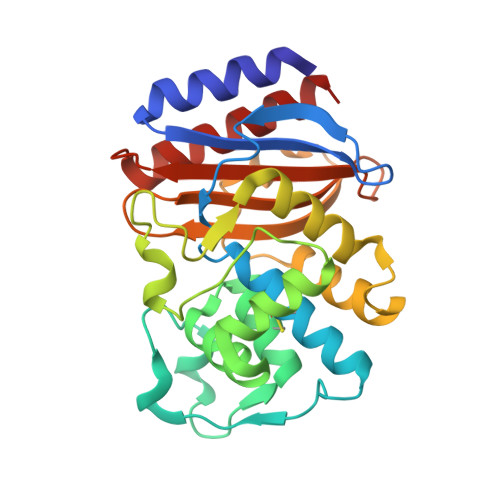Noncovalent interaction energies in covalent complexes: TEM-1 beta-lactamase and beta-lactams.
Wang, X., Minasov, G., Shoichet, B.K.(2002) Proteins 47: 86-96
- PubMed: 11870868
- Primary Citation of Related Structures:
1JVJ - PubMed Abstract:
The class A beta-lactamase TEM-1 is a key bacterial resistance enzyme against beta-lactam antibiotics, but little is known about the energetic bases for complementarity between TEM-1 and its inhibitors. Most inhibitors form a covalent adduct with the catalytic Ser70, making the measurement of equilibrium constants, and hence interaction energies, technically difficult. This study evaluates noncovalent interactions within covalent complexes by examining the differential stability of TEM-1 and its inhibitor adducts. The thermal denaturation of TEM-1 follows a two-state, reversible model with a melting temperature (T(m)) of 51.6C and a van't Hoff enthalpy of unfolding (DeltaH(VH)) of 146.2 kcal/mol at pH 7.0. The stability of the enzyme changes on forming an inhibitor adduct. As expected, some inhibitors stabilize TEM-1; transition-state analogues increase the T(m) by up to 3.7C (1.7 kcal/mol). Surprisingly, all beta-lactam covalent acyl--enzyme complexes tested destabilize TEM-1 significantly relative to the apo-enzyme. For instance, the clinically used inhibitor clavulanic acid and the beta-lactamase-resistant beta-lactams moxalactam and imipenem destabilize TEM-1 by over 2.6C (1.2 kcal/mol) in their covalent adducts. Based on the structure of the TEM-1/imipenem complex (Maveyraud et al., J Am Chem Soc 1998;120:9748--52), destabilization by moxalactam and imipenem is thought to be caused by a steric clash between the side-chain of Asn132 and the 6(7)-alpha group of these beta-lactams. To test this hypothesis, the mutant enzyme N132A was made. In contrast with wild-type, the covalent complexes between N132A and both imipenem and moxalactam stabilize the enzyme, consistent with the hypothesis. To investigate the structural bases of this dramatic change in stability, the structure of N132A/imipenem was determined by X-ray crystallography. In the complex with N132A, imipenem adopts a very different conformation from that observed in the wild-type complex, and the putative destabilizing interaction with residue 132 is relieved. Studies of several enzymes suggest that beta-lactams, and covalent inhibitors in general, can have either net favorable or net unfavorable noncovalent interaction energies within the covalent complex. In the case of TEM-1, such unfavorable interactions convert substrate analogues into very effective inhibitors.
Organizational Affiliation:
Department of Molecular Pharmacology and Biological Chemistry, Northwestern University, Chicago, Illinois 60611-3008, USA.
















